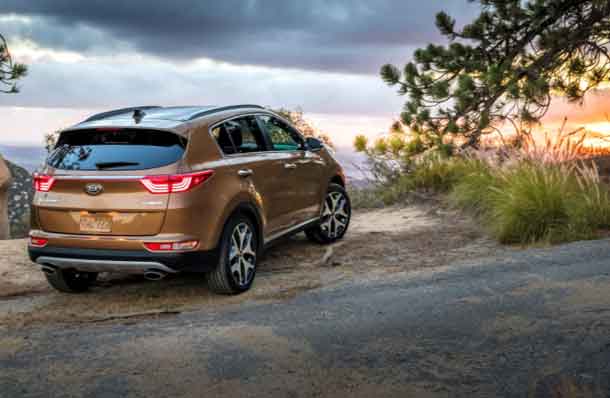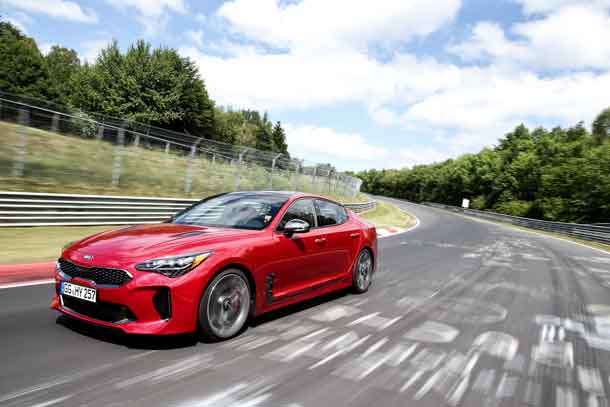
•Stiffer structure, new suspension, advanced driver assistance systems, and premium materials take Sportage to the head of the class
•Cutting-edge design, engaging driving dynamics and intelligent packaging stand out in a staid compact CUV segment
•Optima matures into an expertly crafted sedan with two turbo engine choices
•Passionately Designed and Obsessively Crafted with European Styling, Optima offers a Refined Premium Interior and Significant Ride and Handling Improvements
THUNDER BAY – Winter is a time many people across Northern Ontario look to purchasing a new vehicle. For many in northern communities, winter roads allow them to drive their new vehicle home.
The fourth-generation Sportage, Kia Canada’s longest-running nameplate, wraps stunning contemporary design around a structure that is both stiffer and more spacious than before. Advanced driver assistance technologies, significant suspension and steering improvements, and available intelligent AWD vastly improve the Sportage’s driving dynamics while premium materials and world-class craftsmanship create a class-up experience in an otherwise utilitarian segment.
“The all-new Sportage will bring a breath of fresh air to the compact CUV segment in 2016 with its distinctly European design as well as innovative and premium features,” said Ted Lancaster, Vice President and Chief Operating Officer (COO), Kia Canada Inc. “The thoughtful design elements, functionality, advanced safety features and overall value will position Sportage as a benchmark vehicle among its competitors.”
Designed under the direction of Kia’s president and chief design officer, Peter Schreyer, the 2017 Sportage’s exterior juxtaposes smooth curves with sharp creases. Although every body panel is new, the “face” of the new Sportage features the most significant change over the outgoing model. Kia’s hallmark “tiger-nose” grille resides vertically in the front fascia while the headlights are positioned higher, sweeping back along the outer edges of the sharply detailed hood. A lower, wider front clip – enlarged to provide greater engine cooling – adds visual volume to the lower half of the Sportage’s face, resulting in a planted and aggressive stance, though it keeps the same overall width, 1,854 mm, as its predecessor. The wheelbase has been stretched 30 mm (now 2,669 mm), while overall length has increased 41 mm to 4,480 mm.
Despite its increased dimensions, the all-new Sportage remains instantly recognizable thanks to its sloping roofline and sharply raked rear window. Short overhangs and wheels pushed to the corners continue to be Sportage signatures, while a longer, more aerodynamic spoiler and bolder wheel arches give the compact CUV a more dynamic appearance. Tasteful chrome touches surround the windows, giving the Sportage a more upscale look, while the top-of-the-line SX Turbo model adds more visual interest with new LED fog lamps, HID headlamps, LED tail lights, satin exterior trim, metal-look skid plates, and 19-inch alloy wheels.
Inside, the new Sportage’s driver-oriented cockpit features a simple and modern design with clean horizontal lines emphasizing a more spacious interior. The lateral design of the dashboard divides it into two clear zones. The upper “display” zone delivers information to occupants via the instrument panel and new color touchscreen, which is canted 10 degrees toward the driver. The lower half, or the “control” zone, features easily identifiable switchgear to operate the available dual-zone climate system, audio and secondary controls.
Upper trim models add sumptuous leather upholstery, and the SX Turbo model includes a D-shaped, heated and leather-wrapped steering wheel with paddle shifters, piano black trim along the center console, aluminum alloy pedals, and authentic stitching on the dashboard.
As a result of the increased exterior dimensions and clever packaging, interior dimensions have grown, offering more space and comfort. Headroom has increased 5 mm to 998 mm in the front and 15 mm to 993 in the rear, while legroom has increased slightly in front and 8 mm in the rear to 970. The second row has a 40 mm lower interior floor (ground clearance is unchanged at 162 mm for front-drive models and 172 mm on AWD) and 30 mm lower rear bench hip point, benefitting second-row passengers with more headroom (up more than a half inch) and a more comfortable seating position. Offering even more comfort are options such as three-level front seat heaters, 10-way power control with lumbar support for the driver’s seat.
Just as passenger space has increased, so has cargo room. Thanks to an innovative dual-level cargo floor and a widened luggage area, cargo capacity behind the second row has grown substantially from 739 L to 869 L (SAE). A Smart Power Liftgate™, which automatically opens when the key fob is within three feet of the vehicle, is also available.
Outward visibility has been improved by mounting the side mirrors lower on the doors, using thinner A- and C-pillars and incorporating larger rear glass in hatch. This feeling of spaciousness is further enhanced with an available panoramic sunroof that is 104 mm longer than the outgoing model’s.
Kia engineers reduced noise, vibration, and harshness (NVH) through the application of a quad-bushing setup in the rear suspension to isolate road noise and additional sound-absorbent materials throughout the Sportage’s wheel arches. Wind noise also is reduced as a result of thicker front side glass, a lip seal for the panoramic sunroof, and additional soundproofing in the doors. The 2017 Sportage is also more aerodynamic, with a coefficient of drag that’s been reduced from .37 cd to .35 cd.
The completely redesigned fully independent front suspension achieves a leap forward in ride quality. A four-point bushing setup delivers greater stability and a more natural response to changing road surfaces, while stiffer wheel bearings and bushings result in more precise handling. The fully-independent rear suspension now adopts a dual-member shock absorber housing, while both AWD and FWD models now benefit from a dual lower-arm multi-link setup. The SX Turbo has been uniquely tuned with firmer shock absorbers to deliver sharper handling befitting its athletic personality.
The 2017 Sportage is offered in front or all-wheel-drive, both coupled with a six-speed Sportmatic transmission. The Dynamax intelligent AWD system is available on every trim and features a 50/50 locking center differential. The system senses, anticipates, and optimizes traction requirements for all road and weather conditions. AWD models feature a unique front fascia with a steeper approach angle for increased capability.
Steering is another area of improvement, as engineers mounted the steering box farther forward on the axle for better weight distribution. With 25 percent less friction than the previous unit, the 2017 Sportage offers smoother and more precise steering inputs and better feel.
Efficiency and driving performance were two major areas of focus when retuning the engines. The hard-charging 2.0-liter inline-four turbo found on the SX Turbo makes 241 horsepower and 260 lb.-ft. of torque and has been retuned to target improved fuel efficiency and offer better midrange torque. The normally aspirated 2.4-liter engine that produces 181 horsepower and 175 lb.-ft. of torque is also retuned to target better fuel efficiency.
Passionately designed and obsessively crafted, the all-new 2016 Optima maintains its athletic identity but rides on a chassis that is longer, wider and stiffer for improved ride and handling and a more spacious cabin. Available with three engine choices, including a new 1.6-liter turbocharged four-cylinder that’s mated to a seven-speed Dual Clutch Transmission (DCT), the Optima is more confident than ever on the road. Like the 2016 Sorento, the all-new Optima is built at Kia’s plant in West Point, Georgia.
“The previous generation Optima held award-winning, world class design and was one of the contributing factors for changing the way people felt about our brand. From the advanced safety features to the premium materials and fun to drive turbo engines, the all-new 2016 Optima has matured in all the right ways,” said Ted Lancaster, Vice President and Chief Operating Officer (COO), Kia Canada Inc. “The fresh yet distinctive new iteration of the Optima certainly stays true to its head-turning design attributes and is a perfect example of our “Power to Surprise” brand slogan.”
Because the previous generation Optima was such a success story for the brand, Kia’s designers had to strike a delicate balance, retaining the identity of the vehicle while, at the same time, making a confident move forward to keep the car modern and fresh. Sweeping contemporary surfaces and modern architecture inspired the design of the all-new Optima, leading to a sophisticated and dynamic sedan that is instantly recognizable yet has more road presence than ever.
The all-new Optima is boldly designed to be functional and sporty with exterior dimensions that are marginally longer, taller and wider. The wheelbase has been extended to 2,804 mm (increased 10 mm), and the vehicle has been widened to 1,859 mm (increased 30 mm). Both changes enable a roomier and more comfortable cabin with more head room, shoulder room and rear seat leg room. The increased dimensions also allow for more cargo capacity in the trunk, up 14 L. from the previous-generation Optima to 450 L.
The aggressive front clip pulls the sheet metal taut over the wheel arches, and the swept-back headlights reach deeply into the fenders. On the upper level trims, Kia’s signature grille is hot stamped and composed into a sophisticated pinpoint design. The all-new Optima introduces Kia’s first application of Bi-Xenon HID headlights with available Dynamic Bending Lamps, which illuminate the tarmac around corners, and High Beam Assist. The 2016 Optima rides on alloy wheels ranging from 16 to 18 inches, with four new unique wheel designs, depending on trim level.
Optima’s interior is larger and more comfortable with an innovative and functional cabin that is well-appointed with class-up touches. Drawing inspiration from Kia’s premium and luxury sedans, the Optima utilizes more soft-touch materials throughout the passenger compartment. Optima’s luxurious interior is obsessively crafted with an impressive attention to detail and features real stitching along the dash and doors, complemented by tasteful metallic accents, varying by trim level. The driver-oriented cabin has been simplified with a cleaner, more unified design than the previous generation. A stronger horizontal plane and a wider center console help create a greater sense of space. By grouping and reducing the number of functional keys and buttons, Kia’s already-superior ergonomics are markedly improved.
The interior design team also paid particular attention to seat comfort. A stiffer seat frame reduces vibration; soft foam in the headrest and upper back, and denser, more supportive foam in thigh-support areas allow occupants to nestle into seats with deeper side bolsters. For extra convenience, heated and ventilated front seats are available with power adjustable driver and front passenger seats. For added convenience, the 2016 Optima offers a height-adjustable front passenger seat, a feature normally found only in premium vehicles. Depending on trim level, the seats are covered in cloth, leather or luxurious Nappa leather trim.
Optima is Kia’s pilot vehicle for the introduction of Android4 Auto™ which allow drivers to access a suite of core functions from their smartphones. After connecting their smartphone to the head unit via the vehicle’s front USB port (two additional fast-charge USB ports and rear 12V outlet are located in the center console for the front and rear seat passengers), the 8-inch touchscreen screen displays the smartphone’s most important features. Core functions including music, messaging, navigation and voice calls are available via the screen, the steering wheel or via voice command. While the standard six-speaker audio system will satisfy all but the most demanding enthusiasts, true audiophiles will gravitate to a Kia-first available Harman/Kardon QuantumLogic™ Premium Surround Sound Audio System, which includes 10 speakers, Clari-Fi™ technology and an upgraded 630-watt digital amplifier. Clari-Fi is a patented music restoration technology that rebuilds audio signals that are lost in the digital compression process. This technology breathes new life into your favorite music, restoring a high-fidelity listening experience to any compressed digital source. Optima’s Harman/Kardon premium audio system also comes equipped with next-generation QuantumLogic™ Surround Sound technology, which extracts signals from the original recording and redistributes them into an authentic, multidimensional soundstage for playback that is clear, refined and detailed.
The all-new Optima takes convenience to the next level with a long list of available technologies across the various trim levels. Optima offers an available rear-camera display while the top trim model offers a 360-degree Surround-View Monitor. Available driver-aid technology, including Advanced Smart Cruise Control (ASCC), Blind Spot Detection (BSD) with Lane Change Assist, Rear Cross Traffic Alert (RCTA), Rear Parking Assist System (RPAS), Front Collision Warning System (FCWS), Lane Departure Warning System (LDWS) and Autonomous Emergency Braking (AEB) – which, under appropriate conditions, will bring the vehicle to a complete stop to potentially avoid a collision or reduce damage – makes the task of driving easier and more convenient. Also available for the first time on any Kia vehicle are Bi-Xenon HID headlights with Dynamic Bending Lamps (DBL) and intuitive High Beam Assist (HBA), which recognizes oncoming traffic and automatically switches the lights to low beam until the opposing vehicle has
The 2016 Optima features a uniquely engineered body that combines various high-tensile strength steel alloys to create a stiffer chassis that’s more durable thanks to the increased use of Advanced High Strength Steel (AHSS), with more than 50 percent of the all-new Optima’s body constructed from the material. In addition, the greater use of structural adhesive improves NVH and contributes to structural rigidity, as well as a significant increase in hot stamped components. This newer body structure helps provide crash protection, better driving dynamics, and is the foundation for a quieter ride. Additional innovations were implemented to reduce NVH, lighten the vehicle and enhance aerodynamics. The 2016 Optima features a panoramic sunroof support structure made with carbon-fiber-reinforced plastic, which helps reduce weight and lower the vehicle’s center of gravity. A larger full floor under cover helps reduce wind noise and aid fuel efficiency. Increased dash insulation, added windshield side molding, acoustic laminated front door windows and the increased use of structural adhesive ensure a quiet ride with reduced road and wind noise. Engine mounts, body panels and wheels all are stiffer on the all-new Optima, reducing vibration, engine noise and road noise. Larger cross-member bushings are utilized to help isolate road and engine noise, as well as reducing engine vibration through the floor and steering wheel.
Improving ride and handling was a top priority for engineers. Overall, the chassis is lighter and stiffer, resulting in 58 percent more torsional rigidity than the outgoing model, which contributes to improved steering response, high-speed stability and handling. Moving the suspension points outward optimizes suspension geometry for a smoother ride over uneven pavement. Available Rack-mounted Motor Driven Power Steering (R-MDPS) improves steering response with a higher gear ratio.
The all-new Optima is available with three engine choices, striking a performance balance between sportiness and fuel efficiency. Two powerplants carry over from the previous generation, the 2.4-liter GDI four-cylinder, and the 2.0-liter GDI turbo engine. The 2.4-liter produces 185 horsepower at 6,000 rpm and 178 lb.-ft. of torque at 4,000 rpm. The 2.0-liter turbo generates 245 horsepower at 6,000 rpm and 260 lb.-ft. of torque at 1,350 rpm. Both engines are mated to a six-speed automatic transmission with Sportmatic® shifting. Both engines have been retuned for fuel economy and better performance and drivability with maximum torque now available at lower RPM
All new for the 2016 model is a 1.6-liter four-cylinder turbo engine. Pushing out 178 horsepower at 5,500 rpm and a stout 195 lb.-ft. of torque at just 1,500 rpm, the new engine mates to a seven-speed DCT, a first for the Kia brand. The transmission optimizes the engine’s responsiveness for a sporty feel that doesn’t sacrifice fuel economy. Also new for the Optima, Michelin® tires are available on select trims. All three engines channel energy through the front wheels. The 2016 Optima is available in 7 different trims (LX, LX+, LX Eco-Turbo, EX, EX Tech, SX and SXL) with MSRP ranging from $23,495 (LX) to $37,595 (SXL).





